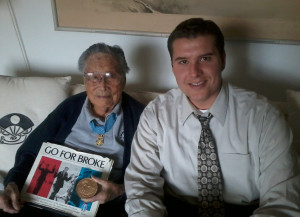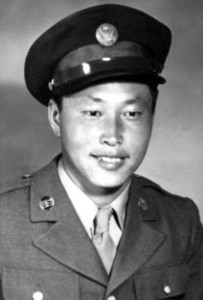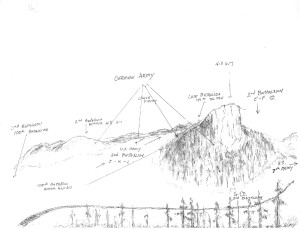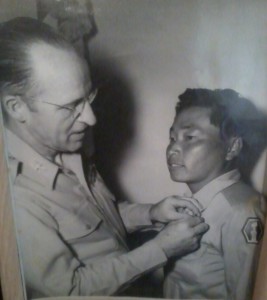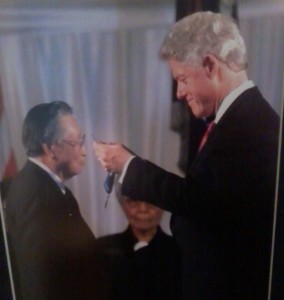Remembering Joe Sakato
Use controls above or click here to open this Hometown Heroes podcast in a new window
Episode #399 of Hometown Heroes, airing December 26-27, 2015, serves as a tribute to George T. “Joe” Sakato, who passed away earlier in December at the age of 94.
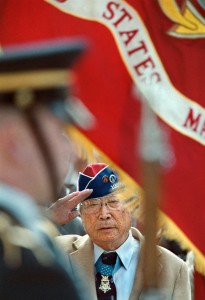
(Michael Williamson/The Washington Post)
George T. “Joe” Sakato on Veterans Day, 2000 in Washington, D.C. Click HERE to read Joe’s obituary in the Washington Post.
I had the privilege of meeting Joe in 2011 when he welcomed me into the Denver, CO area home he shared with his daughter, Leslie. He struck me as a humble and unassuming man, sincerely grateful that he had survived, and determined to use the platform the Medal of Honor afforded him to honor the legacy of those who never returned.
Listen to Hometown Heroes to hear Joe explain the confusion over his first name, his recollections of December 7, 1941, and how he ended up in the famed 442nd Regimental Combat Team. His 21st birthday, February 19, 1942, is a day which lives in infamy for Japanese-Americans as the day President Franklin D. Roosevelt issued Executive Order 9066. That authorized the “relocation” of 120,000 Japanese-Americans from the West Coast to internment camps throughout the country. Joe and his family avoided being incarcerated in one of the camps by moving on their own to Arizona and working for a rancher there. Joe would get a first-hand taste of the harsh conditions of the Poston and Gila River camps when he would go in to pick up extra farmhands and then return them to the camp. Not wanting to end up in a similar situation, he decided to enlist in the U.S. Army Air Corps.
“Draft card says 4C, enemy alien,” Joe remembered being told.
No amount of pleading would change that classification. It wasn’t until the Nisei soldiers of the “Purple Heart Battalion” proved their mettle in Italy that the pathway for Joe to serve his country opened up. He again tried to join the Army Air Corps, but ended up instead in the 442nd Regimental Combat Team. You’ll hear him describe his first taste of combat in the Vosges Mountains, the first time he was wounded, and the first time he saw one of his fellow soldiers killed.
You’ll also hear him explain, from his perspective, the signature accomplishment of the “Go For Broke” soldiers of the 442nd, the rescue of “The Lost Battalion” in late October, 1944. 211 men from the 1st battalion, 141st Infantry Regiment, 36th Infantry Division, most of them Caucasian, were rescued by the 442nd RCT, which suffered more than 800 casualties in the process. Joe Sakato was wounded and taken out of action before the rescue was complete. You’ll hear him explain what he did, and you can also read about it in this citation. Wounded, but still ambulatory, he made his way toward an aid station.
“I’m the only one there, going toward the aid station,” You’ll hear him recall.
“The Germans sent up a mortar shell. It landed ten feet away from me, picked me up, and blew me closer to the aid station.”
Joe spent the next three months, including Thanksgiving, Christmas, and New Year’s, in a hospital in France. More hospital time followed in England, where a “buzz bomb” attack grabbed his attention. In May, 1945, he was still recuperating from his injuries in a Vancouver, WA hospital when a letter from home brought interesting news.
A newspaper clipping from Redlands, CA, where Joe had grown up and graduated from high school, revealed that he had been awarded the Distinguished Service Cross. Listen to Hometown Heroes to find out what that meant to him at the time, and also how close he came to being killed. You’ll hear him catalog some of his close calls, and also posit a guess as to why he survived when others did not.
“Being short kind of helped,”
the 5’4″ veteran quipped during our interview, explaining that riflemen often shot right over his head, while fellow soldiers around him were hit. The citation for the Distinguished Service Cross detailed some impressive heroics, but Joe rarely discussed his heroics as he got on with civilian life in post-war America. He spent more than 30 years working for the U.S. Postal Service in Denver. His wife, Bess, was still living when he received word that his decoration was being upgraded to the Medal of Honor in 2000.

